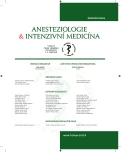What is cold diuresis and why it is impossible to consider „sufficient diuresis“ as a clinical hallmark of excluding hypovolemia or renal hypoperfusion in hypothermic patiens
Authors:
Černý Vladimír
Authors‘ workplace:
Klinika anesteziologie, resuscitace a intenzivní medicíny Fakultní nemocnice Hradec Králové
Published in:
Anest. intenziv. Med., 24, 2013, č. 5, s. 344-345
Category:
Postgraduate education - Selected Topics in Clinical Physiology
Sources
1. Bergman, R., Braber, A., Adriaanse, M. A., van Vugt, R.,Tjan, D. H., van Zanten, A. R. Haemodynamic consequences of mild therapeutic hypothermia after cardiac arrest. Eur. J. Anaesthesiol., 2010, 27 (4), p. 383–387.
2. Polderman, K. H. Mechanisms of action, physiological effects, and complications of hypothermia. Crit. Care Med., 2009, 37(7 Suppl), p. S186–202.
3. Sabharwal, R., Johns, E. J., Egginton, S. The influence of acute hypothermia on renal function of anaesthetized euthermic and acclimatized rats. Exp. Physiol., 2004 , 89 (4), p. 455–463.
4. Broman, M., Källskog, O., Nygren, K., Wolgast, M. The role of antidiuretic hormone in cold-induced diuresis in the anaesthetized rat. Acta Physiol. Scand., 1998, 162 (4), p. 475–480.
5. Granberg, P. O. Alcohol and cold. Arctic. Med. Res., 1991, 50 Suppl 6, p. 43–47.
6. Granberg, P. O. Human physiology under cold exposure. Arctic Med. Res., 1991, 50 Suppl 6, p. 23–27.
7. Cupples, W. A., Fox, G. R., Hayward, J. S. Effect of cold water immersion and its combination with alcohol intoxication on urine flow rate of man. Can. J. Physiol. Pharmacol., 1980, 58 (3), p. 319–321.
Labels
Anaesthesiology, Resuscitation and Inten Intensive Care MedicineArticle was published in
Anaesthesiology and Intensive Care Medicine

2013 Issue 5
Most read in this issue
- Multiple organ dysfunction syndrome
-
Skórovací schémata hodnocení sedace a výskytu deliria
I. Přehled skórovacích systémů hloubky sedace na JIP - Pre-eclampsia, eclampsia and HELLP syndrome from the anaesthesiologist’s perspective
- Ultrasound assessment during admission of trauma and shocked patiens (FAST)
